| English Page |
| JION-ZENJI TEMPLE |
Jion-Zenji is a Zen temple, that was founded in the 16th century by a feudal lord
named Endo Yoshitaka. The main priest of the temple. Hanzan, was appointed
with the recommendation of the top rank priest, Enmyo, who lived in the
Myoshin-ji Zen temple in Kyoto.
The statue of the historical Buddha is located in the main hall.
There are four mausoleums in the temple compound, which are dedicated
to the past four feudal lords who have governed the fief.
This temple has been granted the honorary title of "protection of
the states". This title was written by a royal prince, master or calligraphy, and
made into a plaque in the 17th century.
Later, the Zen monastery was added to the site. At this time, Priest Torin was
the head monk of the temple.
Unfortunately, in 1893, a terrible flood destroyed all the temple buildings, except
for the main gate and a gate used exclusively for the imperial messengers.
The reigning emperor of the time, Emperor Meiji, sent one of his chamberlations
to inquire about the damages.
Three years after the flood, the temple was restored and remains as it
is now. |
| TETSUSO-EN GARDEN |
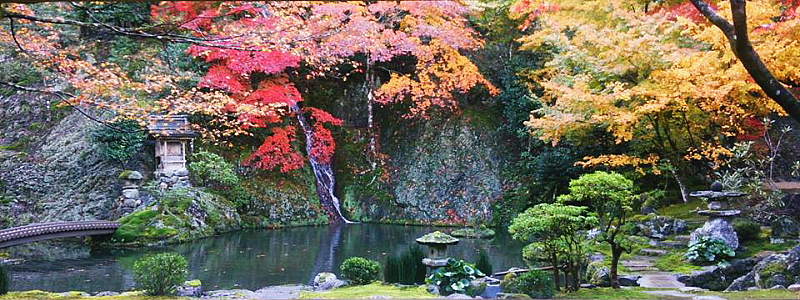 |
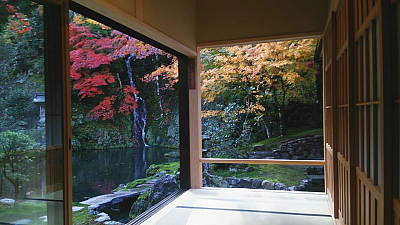 |
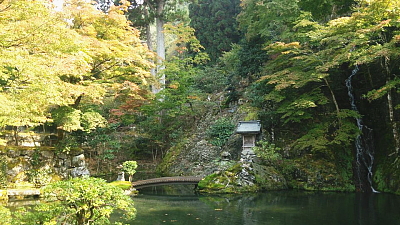 |
|
| Autumn maple leaves until early or mid-November |
A refreshing garden with young buds |
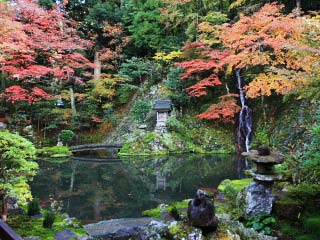 The garden was designed by a Zen priest named Hanzan. A pond surrounded
by maple trees was constructed against the background of rock-mountains. The
endless resonant sound of a waterfall creates a splendid and profound atmosphere. The garden was designed by a Zen priest named Hanzan. A pond surrounded
by maple trees was constructed against the background of rock-mountains. The
endless resonant sound of a waterfall creates a splendid and profound atmosphere.
This type of garden is classified as a "strolling pond garden"
and is also an example of a Muromachi-era style garden. This garden should
be viewed from a sitting position. Through the garden gate, path leads
to a room in which tea ceremonies are held.
In this garden, the beauty of each of the four seasons can be seen. You can see the
new green of early summer, the colorful leaves of autumn, and the white
snow of winter.
Yorikane Kanamori, a feudal lord who reigned in the 17th century, devoted
himself to preserving the landscape of the Jion Zen Temple. His books are
treasures of the temple. |
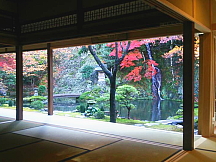 |
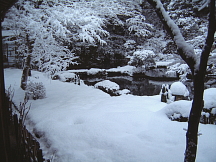 |
|
|
| The view of the garden from inside the premises is exceptional. |
|
A special winter atmosphere. |
| SUIKIN KUTSU |
 |
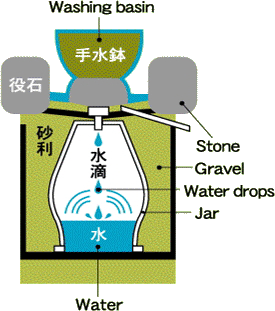
A large earthen jar with a small hole in the bottom is buried upside down in
the ground. The water from the washing basin flows into the jar.
Drops of water splash into the tiny pool below creating a soothing and
spiritual resonance. |
| ACCESS |
| Take the Gifu Bus Meitetsu Shin Gifu Station to the "Hachiman Atago-cho
Jionzenji-mae" bus stop in Hachiman town. The temple is in front of
the bus stop. |
 |
| INFORMATION |
| Address |
〒501-4222 339 Shimadani, Hachiman-cho, Gujo-shi, Gifu-ken |
| Access |
5 minutes (2 km) from the Gujo Hachiman Interchange on the Tokai-Hokuriku
Highway
via National Highways 156 and 256 |
| Phone / Fax |
0575-65-2711 / 0575-65-5178 |
| Business hours |
10:00 a.m. - 4:00 p.m. |
| Holidays |
Tuesday |
| Language |
English |
| Average budget |
Adults : 500 yen, Elementary & Jr. High Students : 300 yen |
| Parking |
bus : 7, car : 10 |
|
|

